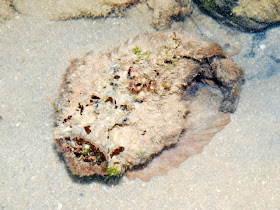Tanah Merah is one of the best places in Singapore to look at marine fish especially during the morning low tides. But we have to constantly be alert not to step on this Mr Stonefish!
Yes, this dreaded Hollow-cheeked stonefish (Synanceia horrida) is the most venomous fish in the world as the spines can inject venom into your foot if you accidentally step on this highly camouflaged fish that looks like a stone. We were glad that Ron found this deadly fish for us to have a closer look. With its quick movements, this is the most active stonefish I have ever encountered! Must be a really potent fellow :P.
Yes, this dreaded Hollow-cheeked stonefish (Synanceia horrida) is the most venomous fish in the world as the spines can inject venom into your foot if you accidentally step on this highly camouflaged fish that looks like a stone. We were glad that Ron found this deadly fish for us to have a closer look. With its quick movements, this is the most active stonefish I have ever encountered! Must be a really potent fellow :P.
Another well camouflaged fish will be this Painted scorpionfish (Parascorpaena picta). Like the stonefish, the scorpionfish also possesses dorsal spines with venom! Though this one is not as deadly.
Here is a good assemblage of some of the different fishies that we have encountered this morning. Some of them were just too quick to be photographed. While others are found in rather deep or murky waters.
Ron found the bright blue juvenile Angelfish (Family Pomacanthidae) that Ria also found earlier this year. Too bad it dwelled in deep and murky waters when I reached to have a look. No photos from me, do look out for Ron's blog for his post.
Ron found the bright blue juvenile Angelfish (Family Pomacanthidae) that Ria also found earlier this year. Too bad it dwelled in deep and murky waters when I reached to have a look. No photos from me, do look out for Ron's blog for his post.
No trip to Tanah Merah would be complete without a sighting of this scary looking Brown-spotted moray (Gymnothorax reevesii). It was busy hunting while we had a look at it.
Here are more special fishy finds! This is a Yelloweye pufferfish (Arothron immaculatus). Pufferfish can inflate themselves with water or air to deter predators. Though they are cute looking, pufferfish have powerful teeth and can give a nasty bite.
This fish is the Brown sweetlips (Plectorhinchus gibbosus). They have swollen lips which show up more prominently in adults. This fish can change colour rapidly from pale patterns to dark.
This fish with a weird shape is a juvenile Batfish (Family Ephippidae). Like the sweetlips, I have seen this batfish before on this shore.
Wow! What is this mass of tiny blobs? Ron first found them and told us that they are Comb Jellies (Phylum Ctenophora).
This is a closeup of two comb jellies. I am not too sure if this mass of comb jellies sighting is a good or bad indication. I have read from this article that while jellyfish blooms can be part of their natural cycle, certain environmental stresses can also lead to proliferation and swarms of these jellies. It has also been reported that masses of comb jellies can eat eggs of fish.
There were also a number of crabs combing on the shore to look for prey to munch on. Such as this Brown egg crab (Atergatis floridus).
Looking like the red version of a Thunder crab (Myomenippe hardwickii), this is actually a Red Stone Crab (Menippe rumphii) that is a relative of the former.
This is another Velcro crab where you can see its legs and attached sponges more obviously.
It was great to come across 4 of these stunning-looking Spotted hermit crabs (Dardanus sp.) which can be found near reefs.
How are the corals doing? There were good growths of juvenile or mid-sized colonies of corals at certain corners of the huge boulders found at the seawall area. None of them were bleaching.
Ron and I also came across a patch of the Common sea stars (Archaster typicus) that survived the oil spill last year.
And while looking for the Saron shrimps that slipped underneath the rocks, he found a rarer cowrie! This is the Arabian cowrie (Cypraea arabica) that we often see on Tanah Merah before the oil spill. Glad to know that they are surviving.
Ending off this blog post with the nudibranch finds, Ron found a pair of Bohol nudibranch (Discodoris boholiensis) that are probably mating.
I found this Black prickly nudibranch (Atagema intecta) that does not seem to be all too healthy. It moved very slowly and was found in a curled position.
Since my trip here on December 2010, I have seen that this shore is doing better after the oil spill. Though it may not be as fantastic as before, I am quite confidently that this shore will recover with time.
Since my trip here on December 2010, I have seen that this shore is doing better after the oil spill. Though it may not be as fantastic as before, I am quite confidently that this shore will recover with time.




















No comments:
Post a Comment